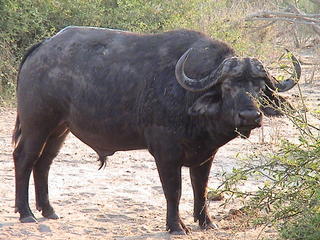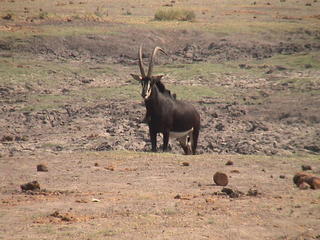
Dead elephant with vultures, buffalo and lone lioness attempting to feed off the carcass


The meanest of the big five? A solitary male buffalo
As the lion approached the dead elephant the birds flew away but a large buffalo moved forward to attack the lion, in defence of the herd. The lion was forced to back off. This was repeated several times until finally the lion gave up and walked away. The vultures then flew back and swarmed over the carcass, completely hiding it from view. The whole scene was a vivid demonstrationof how savage nature can be and how even the most powerful of beasts can be defeated by sheer numbers. We moved on and saw another female lion with one cub. Apparently a second cub had disappeared and, according to our guide, it had most likely died.
On the way back we were treated to a very personal recollection from Stuart, our American heart surgeon from San Diego. As a child he had spent time living in the Chobe and we drove to where his house 'Serondela' used to be. The house was demolished when the park was formed in the 1960's and now it is the Serondela picnic area. He then told us that the movie, The African Queen, was filmed on the Chobe river and we stopped at the spot where a charging elephant was shot in front of Bogart and Hepburn!
We then returned to the lodge, said our farewells and our three cars headed off for the border between Botswana and Namibia, about 50 kms to the west.

A final view of the wonderful wildlife in the Chobe National Park - the very beautiful Sable
At the end of the Caprivi Strip our road joined up with the road from Maun. This is the road the main group will be coming along tomorrow on the longest day of the tour, just under 1,000 kms. They have spent two nights in Maun the main town from which you can explore the Okavango Delta. This is a vast wetlands area where the Okavango River deposits its water. The river does not flow to the sea. It's a shame we have missed this but our 'off piste' trip has been such great fun all six of us feel we made the right decision.
Another 200 kms of dead straight road, running alongside the Okavango River bought us to our overnight stop in Rundu. Our hotel overlooked the river and Angola on the other side. Rundu was used by South Africa as the staging post from which they launched their intervention in the Angolan civil war.
Tomorrow we drive a further 350 kms to the edge of the Etosha National Park, definitely one of the highlights of the whole tour.
No comments:
Post a Comment